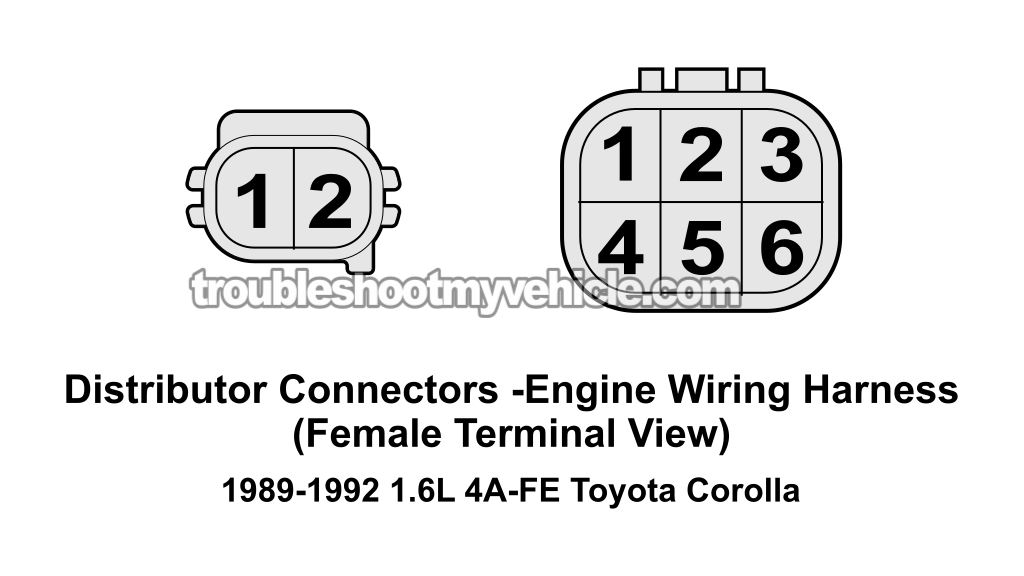TEST 3: Testing The Igniter Control Signal

So far, your initial tests have confirmed:
- The ignition coil isn't sparking.
- The igniter is getting power (TEST 1).
- The igniter has a solid Ground connection (TEST 2).
Now, we'll check whether the fuel injection computer (ECM) is sending an IGT activation signal to the igniter.
As I mentioned at the beginning of this tutorial, when you crank the engine, the computer generates the IGT signal based on input signal from the distributor's pickup coil.
In a nutshell, this IGT signal tells the igniter when to activate the ignition coil.
For this test, we'll use an LED test light to detect the IGT signal while cranking the engine.
IMPORTANT: Do not use a 12 Volt test light instead of an LED light, or you could damage the igniter. If you need to buy an LED light, you can buy it here: Oznium Flush Mount 12V LED Light (at: amazon.com).
IMPORTANT: The distributor must remain connected to both of its electrical connectors for this test to function. To access the IGT signal inside the wire, you'll need to use either a back probe on the connector or a wiring piercing probe. You can see an example of a wiring piercing probe here: Wire Piercing Probe Review (Power Probe PWPPPPP01) (at: easyautodiagnostics.com).
These are the test steps:
- 1
Connect the red LED wire to the black (BLK) wire that corresponds to terminal 1 of the distributor's 6-wire connector.
If you're using a wiring piercing probe to attach the red LED wire, pierce the wire as far away from the connector itself.
NOTE: Both the 2-wire and 6-wire distributor connectors must remain connected their corresponding engine wiring harness connectors. - 2
Connect the black LED wire to the battery negative (-) terminal.
- 3
After the LED light is set up, have your helper crank the engine as you observe the LED light.
- 4
The LED light should flash ON and OFF in steady pulses as the engine is cranking if the IGT signal is present.
Let's take a look at what your test results mean:
CASE 1: The LED light flashed ON and OFF. This is the correct and expected test result and tells you that the igniter is getting its activation signal from the fuel injection computer.
The next step is to make sure that the igniter is now creating the activation signal for the ignition coil. Go to: TEST 4: Testing The Ignition Coil Activation Signal.
CASE 2: The LED light DID NOT flash ON and OFF. This tells you that the igniter is not receiving its activation (IGT) signal from the fuel injection computer.
If the igniter doesn't receive its IGT signal, it's not gonna activate the ignition coil to start creating and sending spark to the spark plug wires.
The most common reason the IGT signal is missing is a defective distributor pickup coil. Your next step is to test the distributor's pickup coil:
TEST 4: Testing The Ignition Coil Activation Signal

By now, your earlier diagnostic tests have confirmed a few things:
- There's no spark from the ignition coil.
- Power's reaching the igniter (TEST 1).
- The igniter's has a solid connection to chassis Ground (TEST 2).
- The igniter's getting the IGT activation signal (TEST 3).
Now, we'll perform one last check —seeing if the igniter's actually activating the ignition coil.
To confirm that the igniter is activating the ignition coil, you're gonna need a 12 Volt test light.
If you don't have a 12-volt test light, here's the one I recommend: Lisle 28400 Heavy Duty 12 Volt Test Light (at: amazon.com).
IMPORTANT: All connectors must remain connected for this test to function.
Let's get started:
- 1
Clip the 12V test light's crocodile clip to the battery's positive (+) terminal.
- 2
Touch the test light's metal probe to the ignition coil terminal labeled (-).
NOTE: Keep the probe in contact with the terminal during the next step. - 3
Have a helper crank the engine while you watch the 12V test light.
- 4
The 12V test light should flash ON and OFF continuously while the engine cranks.
Time to figure out what your test result means:
CASE 1: The 12V test light flashed ON and OFF. That's exactly what should happen.
This confirms that the igniter is generating and sending the activation signal to the ignition coil, meaning the igniter (ignition control module) is working fine.
If you've already checked and verified the following, then the ignition coil is bad and needs to be replaced:
- No spark is coming from the ignition coil.
- The igniter's getting battery power and has a solid Ground connection (TEST 1 and TEST 2).
- The igniter's receiving the IGT activation signal (TEST 3).
- The igniter is activating the ignition coil (this test section).
CASE 2: The 12V test light DID NOT flash ON and OFF. That points to a bad igniter.
The igniter needs to be replaced, but only if you've already confirmed:
- The ignition coil isn't sparking.
- The igniter's getting battery power and has a solid Ground connection (TEST 1 and TEST 2).
- The igniter's receiving the IGT activation signal (TEST 3).
- The igniter IS NOT generating or sending an activation signal to the ignition coil (this test section).
More 1.6L Toyota Corolla Tutorials
You can find a complete list of 1.6L Toyota Corolla tutorials and wiring diagrams in this index:
Here's a sample of the tutorials you'll find there:
- How To Test Engine Compression (1989-1997 1.6L Toyota Corolla).
- How To Test The Throttle Position Sensor (1989-1997 1.6L Toyota Corolla).
- How To Do A Cylinder Balance Test (1989-1997 1.6L Toyota Corolla).
- How To Retrieve Toyota Corolla OBD I Trouble Codes (1990-1995 1.6L Toyota Corolla).

If this info saved the day, buy me a beer!

